Incorporating the Plant Phenological Trajectory into Mangrove Species Mapping with Dense Time Series Sentinel-2 Imagery and the Google Earth Engine Platform
Abstract
1. Introduction
2. Materials and Methods
2.1. Study Area
2.2. Initial S2 Phenological Dataset
- All the available S2 MSI Level-1C top atmosphere images (S2, radiometric and geometric corrected with sub-pixel accuracy) from 2017 and 2018 were used in this study. These have been archived in the GEE platform as an image collection. In total, there are 199 images in this image collection, which means that each individual pixel represents 199 observations over 24 months. The dense time series observations provide sufficient phenological information for mangrove forests.
- The QA60 bitmask band, which contains cloud information, was used to mask out opaque and cirrus clouds and scale the S2 quantification value (10,000). Then, a new image collection that excluded clouds or cirrus pixels was returned. We called the new image collection the S2 image collection (S2IC). We called the pixels in S2IC good observations. As we counted, for each individual pixel, the number of good observations ranged from 102 to 111 (Figure 2).
- The normalized difference vegetation index (NDVI) was calculated for pixels in S2IC. The NDVI, which is the difference between the near-infrared and red bands divided by their sum, is the most commonly used index in studies of global vegetation. Time series changes in NDVI have long been used to represent vegetation phenology [15,25]. In this study, we calculated the NDVI values of each pixel and then built a 10 m spatial resolution time series NDVI image collection, which was called the initial Sentinel phenological dataset (ISPData).
2.3. Reference Data
2.4. Methods
2.4.1. Building High-Quality Sentinel Phenological Dataset (HSPData)
2.4.2. Random Forest Classification and Feature Importance
- Draw 500 (ntree) bootstrap samples from HSPData.
- For each of the bootstrap samples, grow an unpruned classification or regression tree with 5 (mtry) node.
- Predict classification result by aggregating the majority votes of the 500 trees.
- The RF classifier measures the importance of a feature with respect to the classes by Gini Index. The Gini index can be written as:where T is a given training set, f (Ci, T)/|T| is the likelihood that a selected case (pixel) belongs to class Ci. This index is beneficial for studies using multi-source datasets, which contain high dimensional data. It can be used to assure how each input feature influences the classification accuracy, and help to select the features with high importance [27,31]. To evaluate the importance of a certain feature, the RF changes this input features while leaving the rest features constant, and then measures the decrease of the Gini index and mean decrease in accuracy (MDA). The decrease is called the MeanDecreaseGini (MDG), the higher the MDG is, the more important the feature is [28]. MDA is the difference in prediction accuracy before and after permuting variable, averaged over all trees. A high decrease of MDG indicates the importance of that variable [34]. In this study, the MDG and MDA were implemented with the randomForestSRC 2.9.0 package by Ishwaran and Kogalur in 2019. The original classification dataset contained 199 bands for 24 months. To avoid redundant data and noise, 24 cloud free NDVI images were selected in each month to represent 24 months. This dataset was used to validate important months in mangrove species discrimination with the MDG and MDA.
3. Results
3.1. Classification Map and Accuracy Assessment
3.2. Important Months in Mangrove Species Detection
4. Discussion
4.1. Comparison with a UAV-Based Classification Map
4.2. Advantages and Limitations of Phenology-Based Classification
4.3. Advantages of Using Training Samples from UAV Images
4.4. Benefits from Using the Google Earth Engine (GEE) Platform
5. Conclusions
- In Zhangjiang estuary, there were mainly three types of mangrove species (AC, AM, and KO), and one type of invasive species (SA). To build the NDVI time series, we collected 199 scenes of S2 images from 1 January 2017 to 31 December 2018. After removing noise and filling gaps in the initial NDVI time series by the HANTS algorithm, we found that the phenological trajectories of AC, AM, KO, and SA showed great differences (Figure 6).
- The random forest algorithm was applied to the NDVI time series, and the overall accuracy and Kappa confidence of the mangrove species map were 84% and 0.84, respectively. To acquire sufficient high-quality training and validation samples, UAV images were adopted to give pure pixels of different mangrove species.
- The feature importance measurement showed that the months in late winter and early spring played critical roles in mangrove species discrimination. Phenological signatures of nine months (April 2017, January 2017, March 2018, December 2017, February 2018, February 2017, January 2018, November 2018, and March 2017) increased the overall accuracy to 83%.
Author Contributions
Funding
Acknowledgments
Conflicts of Interest
References
- Kamal, M.; Phinn, S. Hyperspectral Data for Mangrove Species Mapping: A Comparison of Pixel-Based and Object-Based Approach. Remote Sens. 2011, 3, 2222–2242. [Google Scholar] [CrossRef]
- Wang, D.; Wan, B.; Qiu, P.; Su, Y.; Guo, Q.; Wu, X. Artificial Mangrove Species Mapping Using Pléiades-1: An Evaluation of Pixel-Based and Object-Based Classifications with Selected Machine Learning Algorithms. Remote Sens. 2018, 10, 294. [Google Scholar] [CrossRef]
- Valderrama-Landeros, L.; Flores-de-Santiago, F.; Kovacs, J.M.; Flores-Verdugo, F. An assessment of commonly employed satellite-based remote sensors for mapping mangrove species in Mexico using an NDVI-based classification scheme. Environ. Monit. Assess. 2017, 190, 23. [Google Scholar] [CrossRef] [PubMed]
- Jia, M.; Wang, Z.; Zhang, Y.; Ren, C.; Song, K. Landsat-based estimation of mangrove forest loss and restoration in Guangxi province, China, influenced by human and natural factors. IEEE J. Sel. Top. Appl. Earth Obs. Remote Sens. 2014, 8, 311–323. [Google Scholar] [CrossRef]
- Alongi, D.M. Carbon payments for mangrove conservation: Ecosystem constraints and uncertainties of sequestration potential. Environ. Sci. Policy 2011, 14, 462–470. [Google Scholar] [CrossRef]
- Gress, S.K.; Huxham, M.; Kairo, J.G.; Mugi, L.M.; Briers, R.A. Evaluating, predicting and mapping belowground carbon stores in Kenyan mangroves. Glob. Chang. Biol. 2017, 23, 224–234. [Google Scholar] [CrossRef]
- Walters, B.B.; Rönnbäck, P.; Kovacs, J.M.; Crona, B.; Hussain, S.A.; Badola, R.; Primavera, J.H.; Barbier, E.; Dahdouh-Guebas, F. Ethnobiology, socio-economics and management of mangrove forests: A review. Aquat. Bot. 2008, 89, 220–236. [Google Scholar] [CrossRef]
- Cao, J.; Leng, W.; Liu, K.; Liu, L.; He, Z.; Zhu, Y. Object-Based Mangrove Species Classification Using Unmanned Aerial Vehicle Hyperspectral Images and Digital Surface Models. Remote Sens. 2018, 10, 89. [Google Scholar] [CrossRef]
- Kuenzer, C.; Bluemel, A.; Gebhardt, S.; Quoc, T.V.; Dech, S. Remote sensing of mangrove ecosystems: A review. Remote Sens. 2011, 3, 878–928. [Google Scholar] [CrossRef]
- Pham, T.; Yokoya, N.; Bui, D.; Yoshino, K.; Friess, D. Remote Sensing Approaches for Monitoring Mangrove Species, Structure, and Biomass: Opportunities and Challenges. Remote Sens. 2019, 11, 230. [Google Scholar] [CrossRef]
- Blasco, F.; Gauquelin, T.; Rasolofoharinoro, M.; Denis, J.; Aizpuru, M.; Caldairou, V. Recent advances in mangrove studies using remote sensing data. Mar. Freshw. Res. 1998, 49, 287–296. [Google Scholar] [CrossRef]
- Vaiphasa, C.; Skidmore, A.K.; de Boer, W.F. A post-classifier for mangrove mapping using ecological data. ISPRS J. Photogramm. Remote Sens. 2006, 61, 1–10. [Google Scholar] [CrossRef]
- Wang, L.; Sousa, W.P.; Gong, P.; Biging, G.S. Comparison of IKONOS and QuickBird images for mapping mangrove species on the Caribbean coast of Panama. Remote Sens. Environ. 2004, 91, 432–440. [Google Scholar] [CrossRef]
- Pastor-Guzman, J.; Dash, J.; Atkinson, P.M. Remote sensing of mangrove forest phenology and its environmental drivers. Remote Sens. Environ. 2018, 205, 71–84. [Google Scholar] [CrossRef]
- Diao, C.; Wang, L. Incorporating plant phenological trajectory in exotic saltcedar detection with monthly time series of Landsat imagery. Remote Sens. Environ. 2016, 182, 60–71. [Google Scholar] [CrossRef]
- Dong, J.; Xiao, X.; Menarguez, M.A.; Zhang, G.; Qin, Y.; Thau, D.; Biradar, C.; Moore, B., 3rd. Mapping paddy rice planting area in northeastern Asia with Landsat 8 images, phenology-based algorithm and Google Earth Engine. Remote Sens Environ. 2016, 185, 142–154. [Google Scholar] [CrossRef] [PubMed]
- Mehlig, U. Phenology of the red mangrove, Rhizophora mangle L., in the Caeté Estuary, Pará, equatorial Brazil. Aquat. Bot. 2006, 84, 158–164. [Google Scholar] [CrossRef]
- Field, C.; Osborn, J.; Hoffman, L.; Polsenberg, J.; Ackerly, D.; Berry, J.; Björkman, O.; Held, A.; MATSON, P.; Mooney, H. Mangrove biodiversity and ecosystem function. Glob. Ecol. Biogeogr. Lett. 1998, 7, 3–14. [Google Scholar] [CrossRef]
- Wang, C.; Jia, M.; Chen, N.; Wang, W. Long-Term Surface Water Dynamics Analysis Based on Landsat Imagery and the Google Earth Engine Platform: A Case Study in the Middle Yangtze River Basin. Remote Sens. 2018, 10, 1635. [Google Scholar] [CrossRef]
- Liu, M.; Li, H.; Li, L.; Man, W.; Jia, M.; Wang, Z.; Lu, C. Monitoring the Invasion of Spartina alterniflora Using Multi-source High-resolution Imagery in the Zhangjiang Estuary, China. Remote Sens. 2017, 9, 539. [Google Scholar] [CrossRef]
- Wang, Q.; Atkinson, P.M. Spatio-temporal fusion for daily Sentinel-2 images. Remote Sens. Environ. 2018, 204, 31–42. [Google Scholar] [CrossRef]
- Jia, M.; Wang, Z.; Wang, C.; Mao, D.; Zhang, Y. A New Vegetation Index to Detect Periodically Submerged Mangrove Forest Using Single-Tide Sentinel-2 Imagery. Remote Sens. 2019, 11, 2043. [Google Scholar] [CrossRef]
- Mao, D.; Wang, Z.; Wu, B.; Zeng, Y.; Luo, L.; Zhang, B. Land degradation and restoration in the arid and semiarid zones of China: Quantified evidence and implications from satellites. Land Degrad. Dev. 2018, 29, 3841–3851. [Google Scholar] [CrossRef]
- Mao, D.; Wang, Z.; Wu, J.; Wu, B.; Zeng, Y.; Song, K.; Yi, K.; Luo, L. China’s wetlands loss to urban expansion. Land Degrad. Dev. 2018, 29, 2644–2657. [Google Scholar] [CrossRef]
- Reed, B.C.; Brown, J.F.; VanderZee, D.; Loveland, T.R.; Merchant, J.W.; Ohlen, D.O. Measuring phenological variability from satellite imagery. J. Veg. Sci. 1994, 5, 703–714. [Google Scholar] [CrossRef]
- Zhu, X.; Hou, Y.; Weng, Q.; Chen, L. Integrating UAV optical imagery and LiDAR data for assessing the spatial relationship between mangrove and inundation across a subtropical estuarine wetland. ISPRS J. Photogramm. Remote Sens. 2019, 149, 146–156. [Google Scholar] [CrossRef]
- Rodriguez-Galiano, V.F.; Ghimire, B.; Rogan, J.; Chica-Olmo, M.; Rigol-Sanchez, J.P. An assessment of the effectiveness of a random forest classifier for land-cover classification. ISPRS J. Photogramm. Remote Sens. 2012, 67, 93–104. [Google Scholar] [CrossRef]
- Breiman, L. Random forests. Mach. Learn. 2001, 45, 5–32. [Google Scholar] [CrossRef]
- Pal, M. Random forest classifier for remote sensing classification. Int. J. Remote Sens. 2005, 26, 217–222. [Google Scholar] [CrossRef]
- Pal, M.; Mather, P.M. An assessment of the effectiveness of decision tree methods for land cover classification. Remote Sens. Environ. 2003, 86, 554–565. [Google Scholar] [CrossRef]
- Trigila, A.; Iadanza, C.; Esposito, C.; Scarascia-Mugnozza, G. Comparison of Logistic Regression and Random Forests techniques for shallow landslide susceptibility assessment in Giampilieri (NE Sicily, Italy). Geomorphology 2015, 249, 119–136. [Google Scholar] [CrossRef]
- Dye, M.; Mutanga, O.; Ismail, R. Combining spectral and textural remote sensing variables using random forests: Predicting the age ofPinus patulaforests in KwaZulu-Natal, South Africa. J. Spat. Sci. 2012, 57, 193–211. [Google Scholar] [CrossRef]
- Mitchell, M.W. Bias of the Random Forest Out-of-Bag (OOB) Error for Certain Input Parameters. Open J. Stat. 2011, 01, 205–211. [Google Scholar] [CrossRef]
- Chehata, N.; Guo, L.; Mallet, C. Airborne lidar feature selection for urban classification using random forests. Int. Arch. Photogramm. Remote Sens. Spat. Inf. Sci. 2009, 38, W8. [Google Scholar]
- Almahasheer, H.; Duarte, C.M.; Irigoien, X. Phenology and Growth dynamics of Avicennia marina in the Central Red Sea. Sci. Rep. 2016, 6, 37785. [Google Scholar] [CrossRef] [PubMed]
- De Alvarenga, A.M.S.B.; Botosso, P.C.; Soffiatti, P. Stem growth and phenology of three subtropical mangrove tree species. Braz. J. Bot. 2017, 40, 907–914. [Google Scholar] [CrossRef]
- Gwadal, P.; Tsuchiya, M.; Uezu, Y. Leaf phenological traits in the mangrove Kandelia candel (L.) Druce. Aquat. Bot. 2000, 68, 1–14. [Google Scholar] [CrossRef]
- Bruzzone, L.; Persello, C. A Novel Context-Sensitive Semisupervised SVM Classifier Robust to Mislabeled Training Samples. IEEE Trans. Geosci. Remote Sens. 2009, 47, 2142–2154. [Google Scholar] [CrossRef]
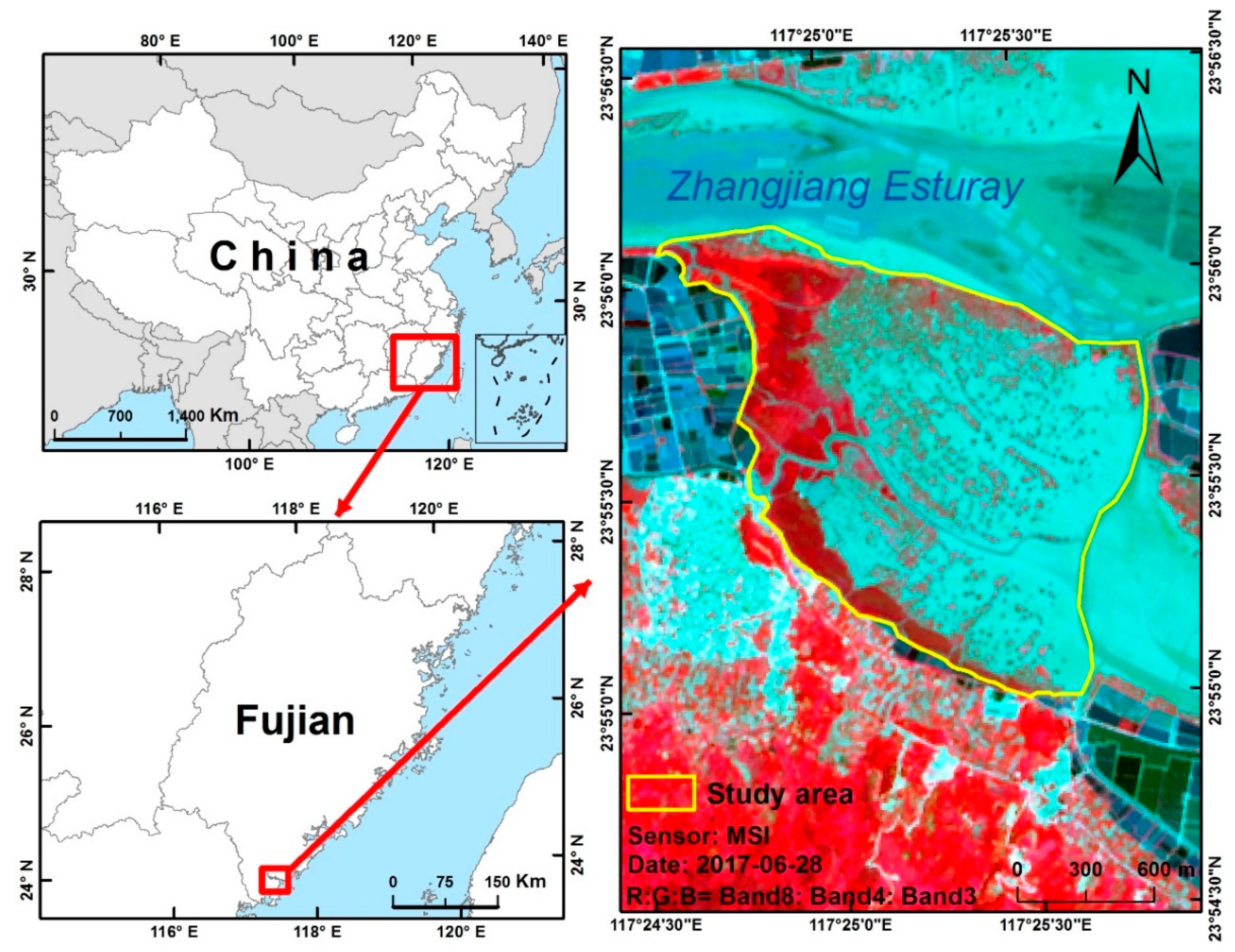
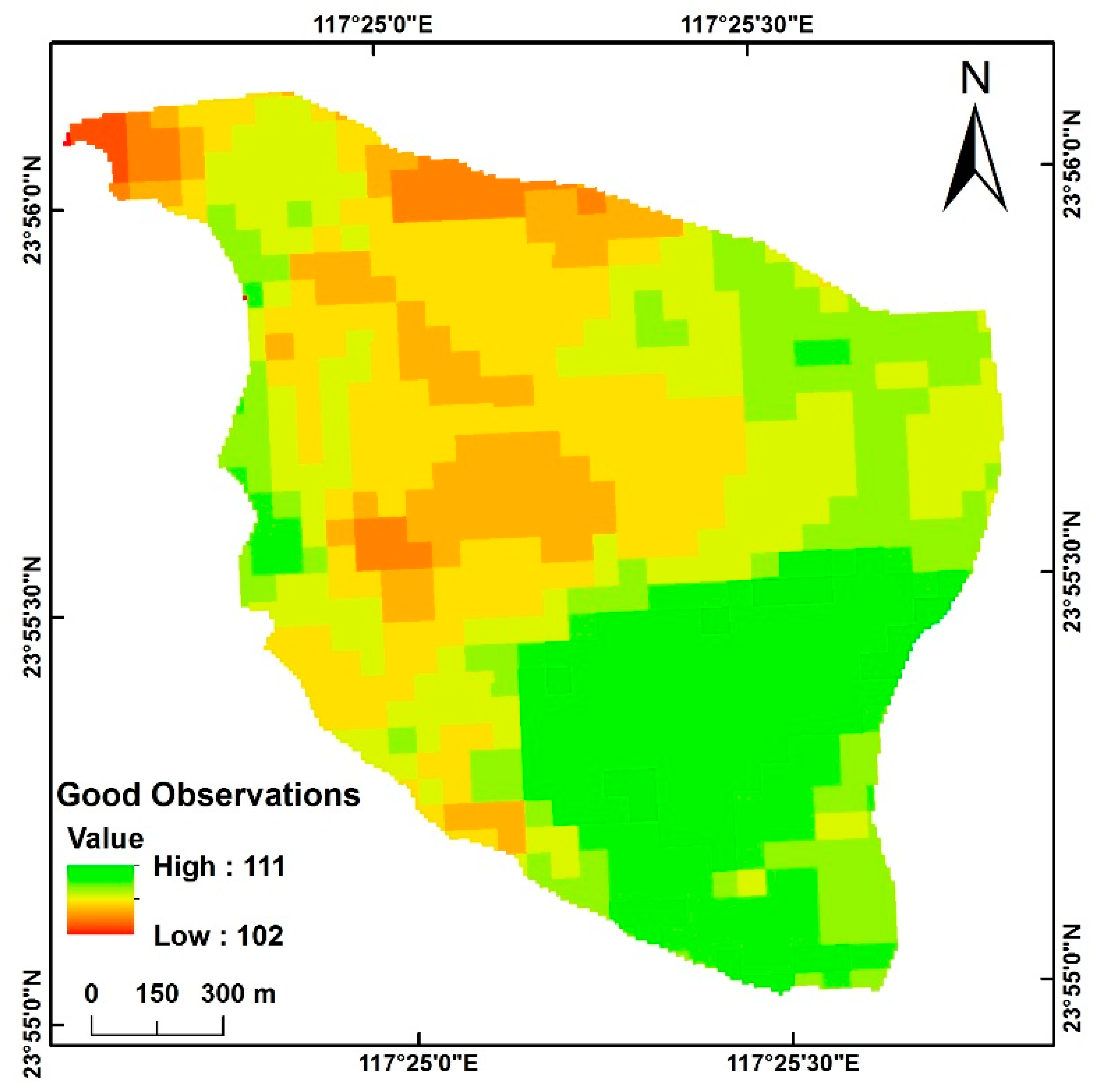
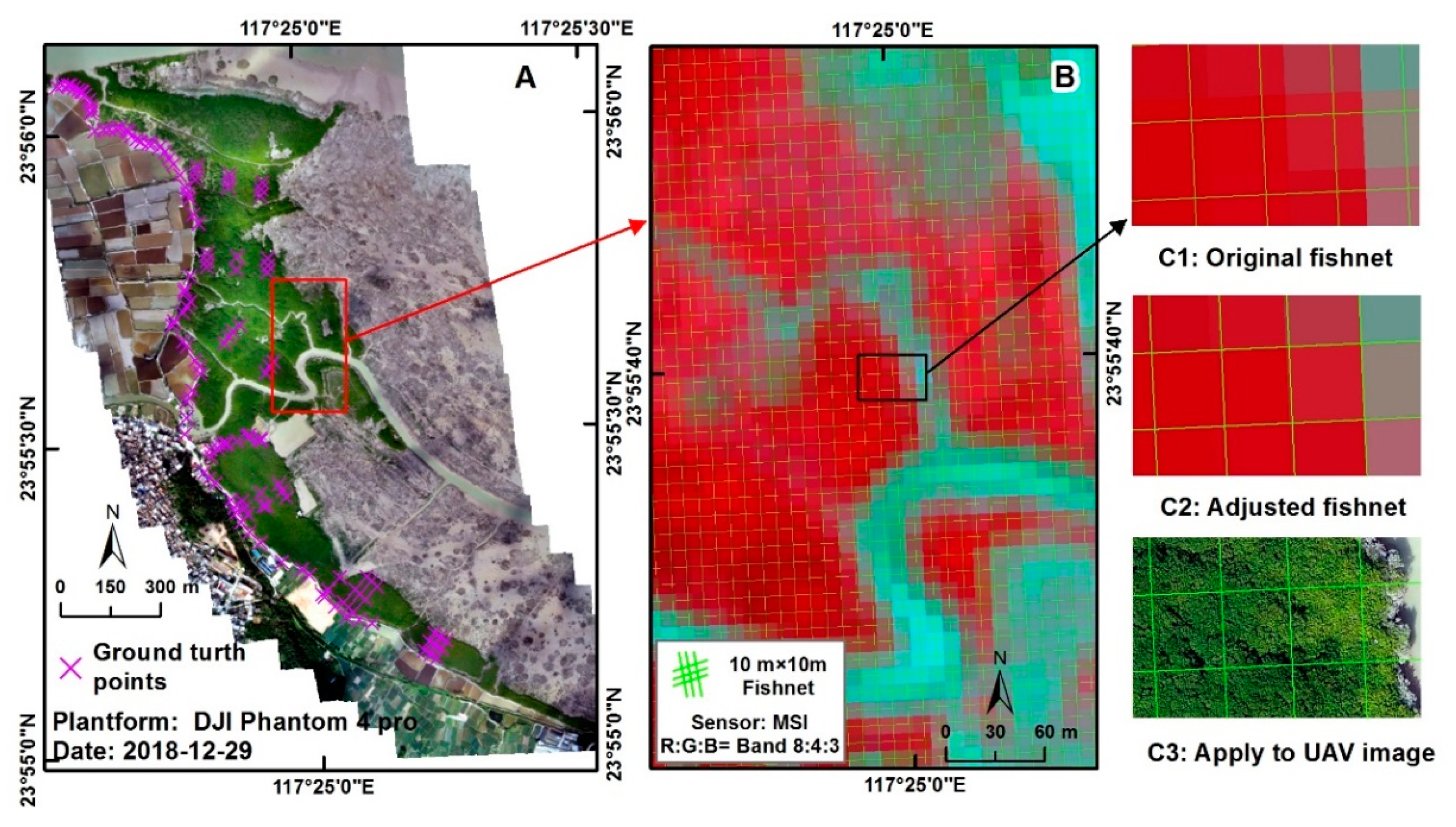
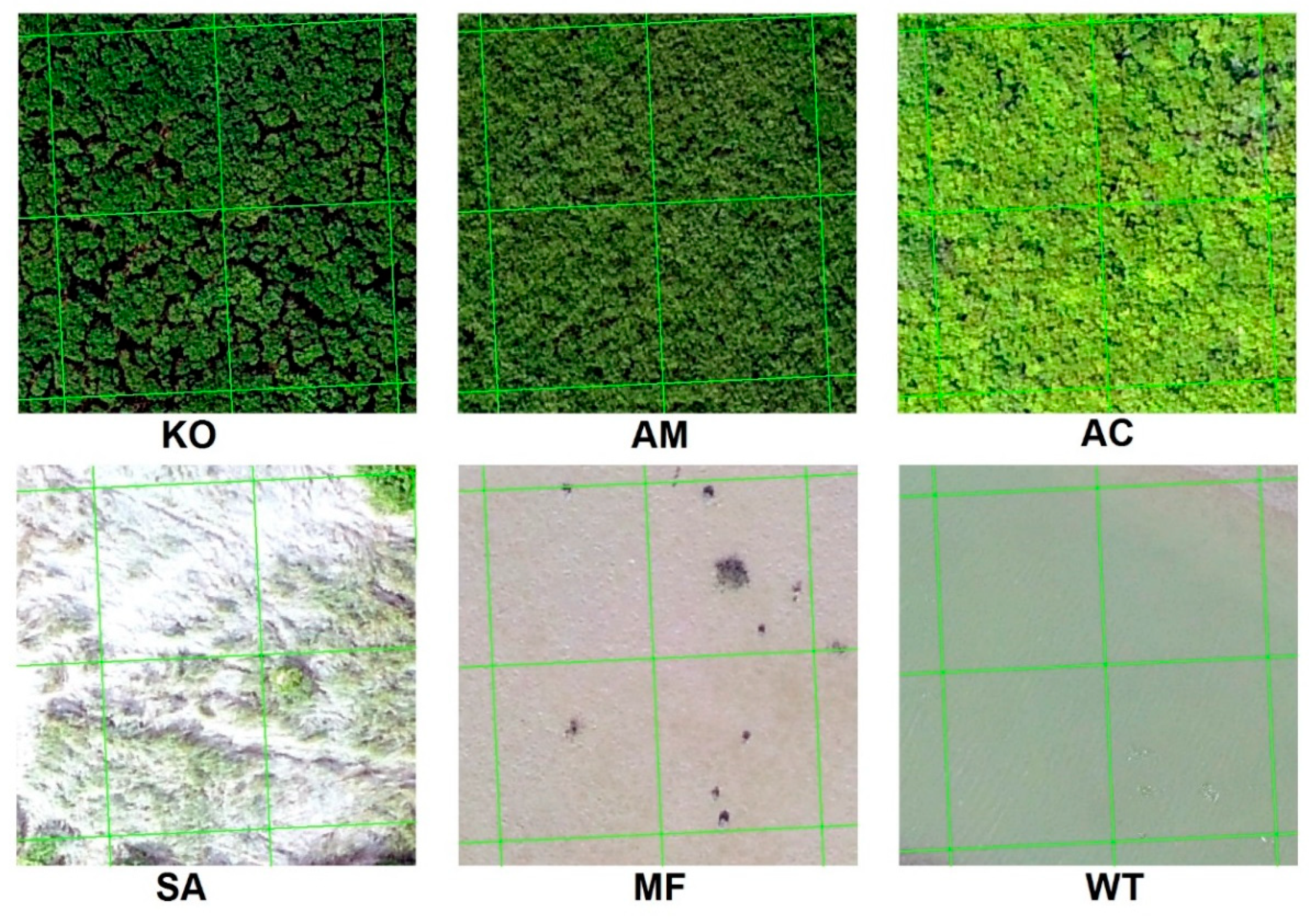
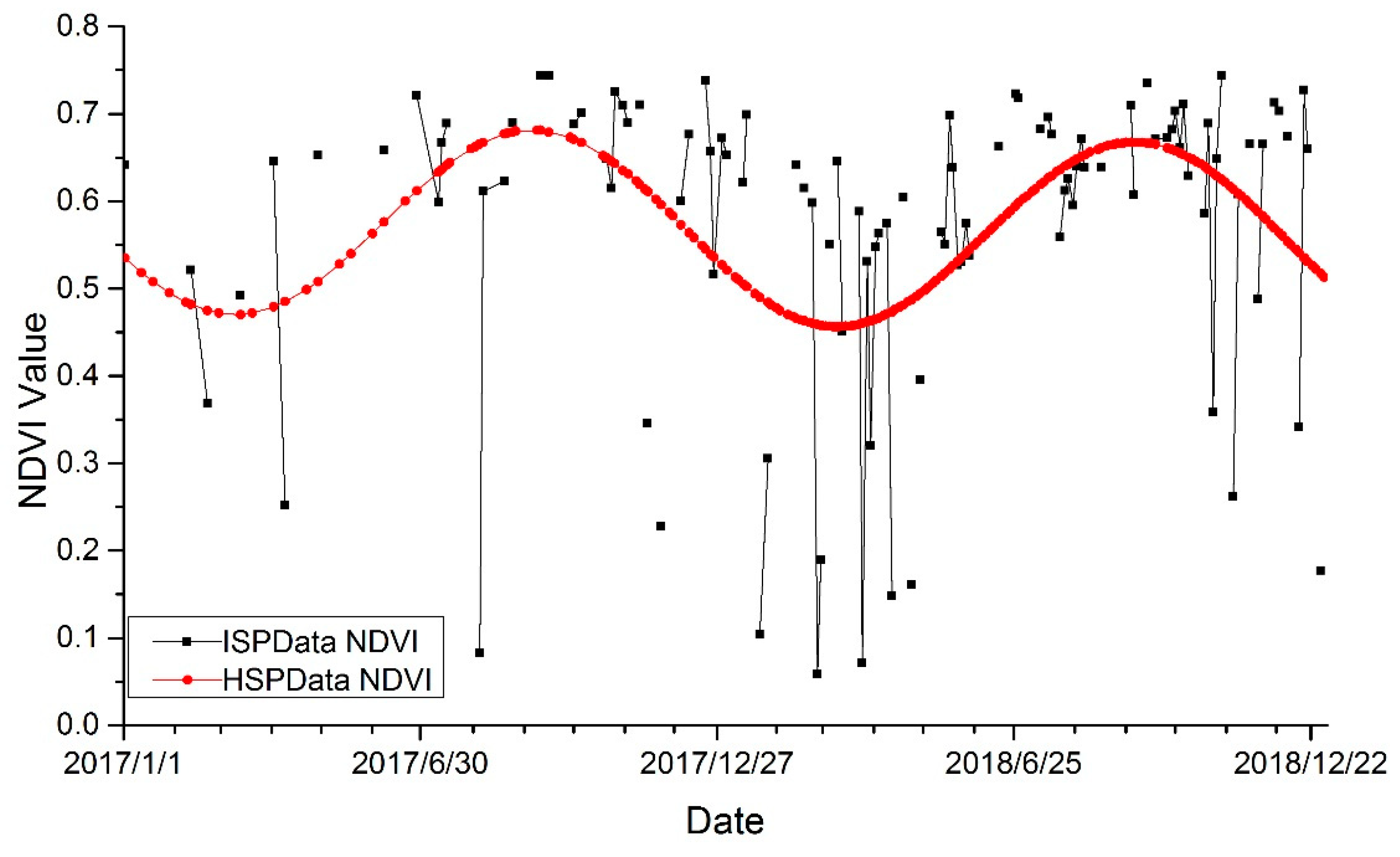
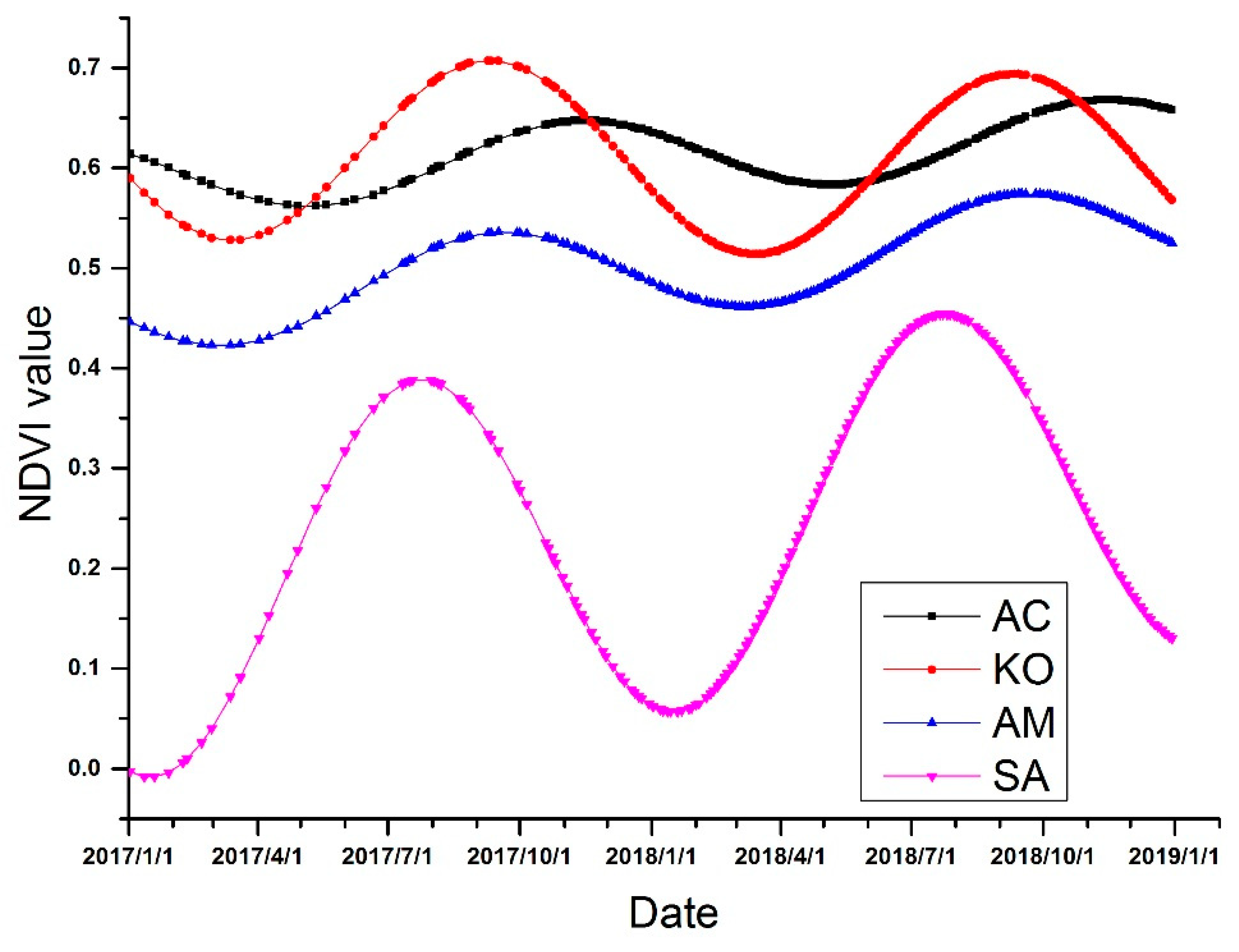

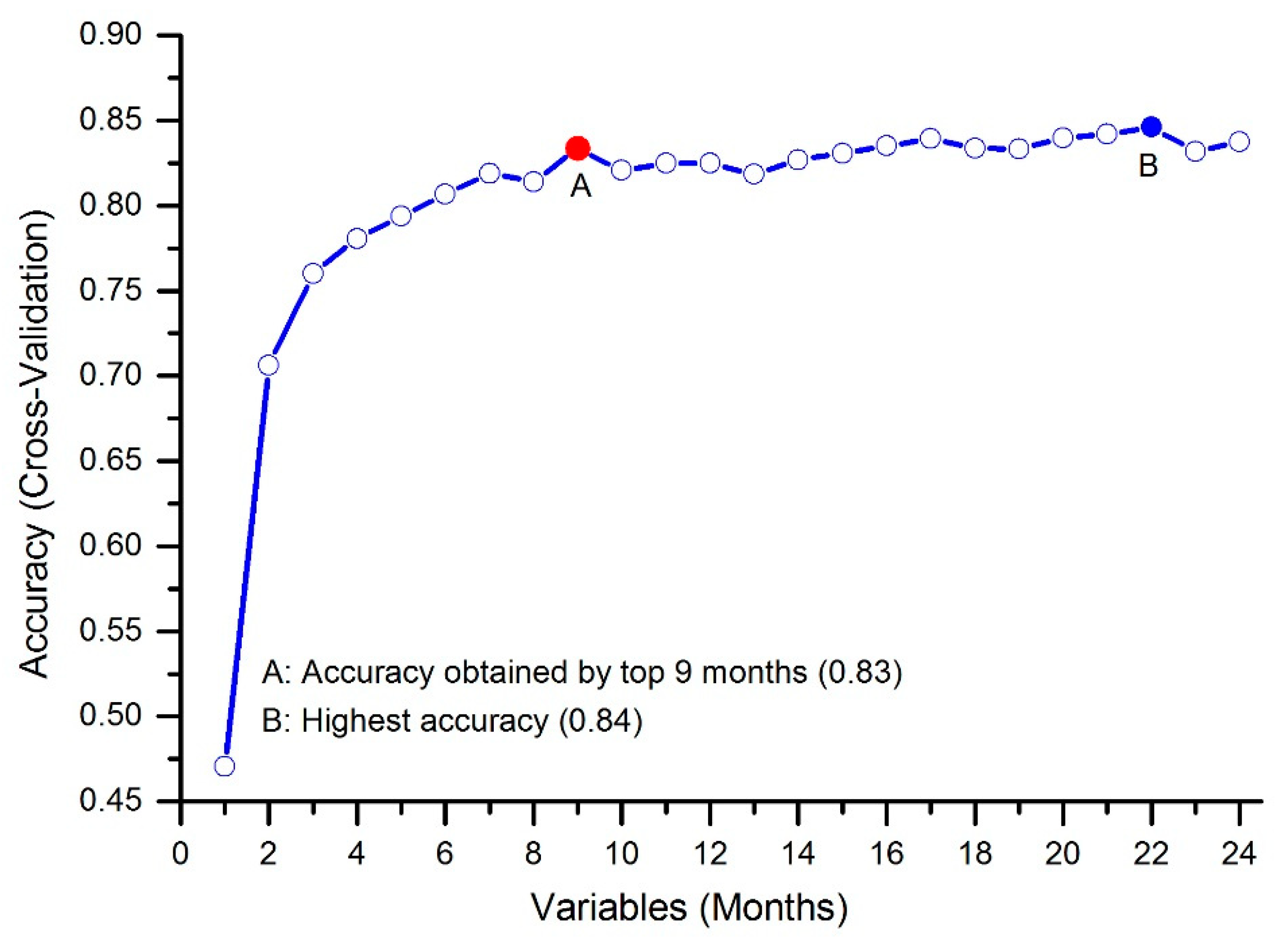
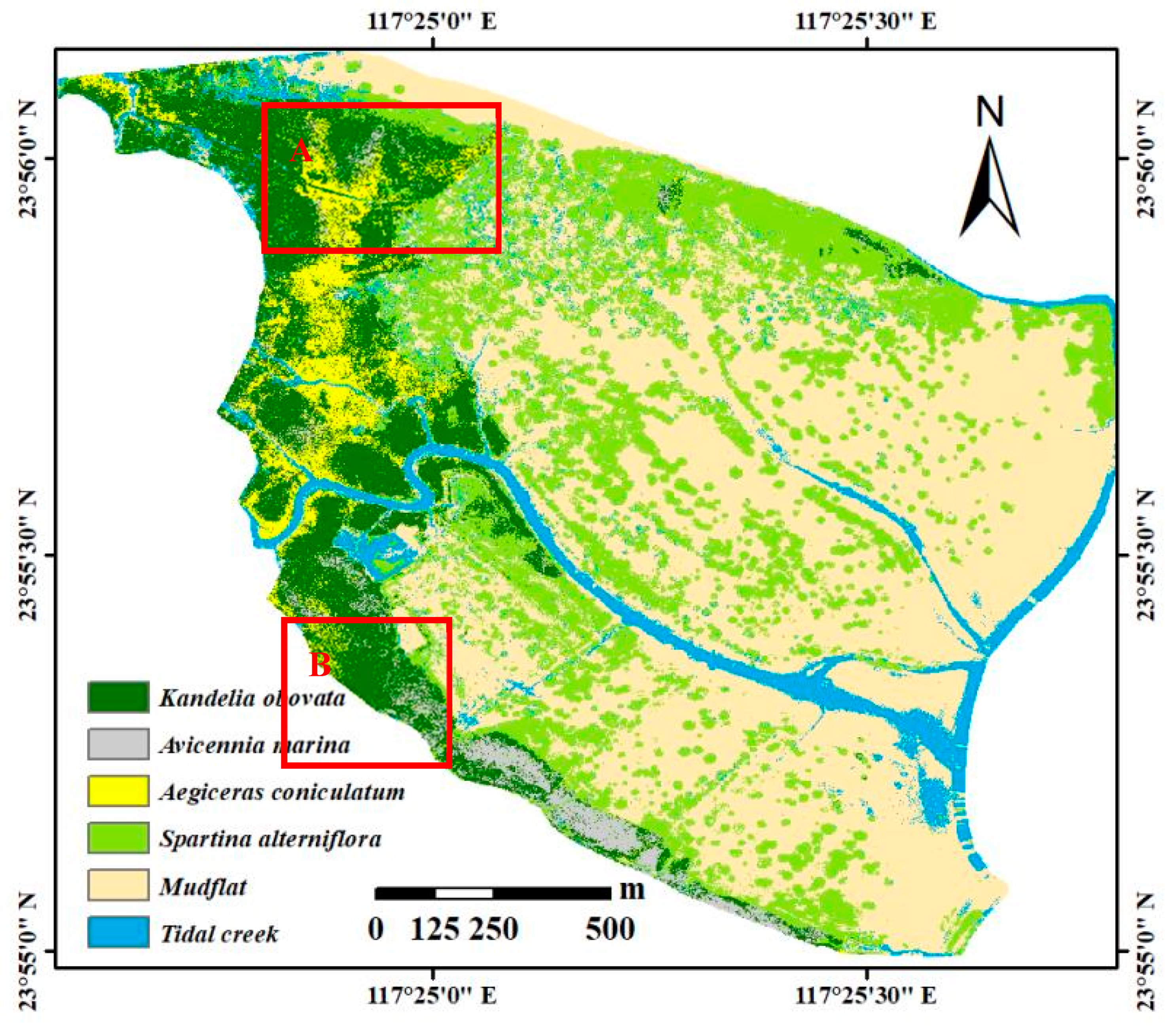
| Land Cover | Classification Results | ||||||
|---|---|---|---|---|---|---|---|
| AC | AM | KO | SA | WT | MF | Producer’s Accuracy | |
| AC | 39 | 2 | 5 | 2 | 0 | 0 | 0.81 |
| AM | 2 | 42 | 0 | 3 | 0 | 1 | 0.88 |
| KO | 7 | 2 | 39 | 4 | 0 | 0 | 0.75 |
| SA | 3 | 1 | 2 | 41 | 2 | 4 | 0.77 |
| WT | 0 | 0 | 0 | 0 | 48 | 2 | 0.96 |
| MF | 1 | 0 | 0 | 3 | 2 | 43 | 0.88 |
| User’s accuracy | 0.75 | 0.89 | 0.85 | 0.77 | 0.92 | 0.86 | - |
| Overall accuracy | 84% | Kappa coefficient | 0.84 | ||||
| No. | Month | MDG | MDA | No. | Month | MDG | MDA |
|---|---|---|---|---|---|---|---|
| 1 | April 2017 | 13.99 | 0.08 | 13 | August 2017 | 8.82 | 0.03 |
| 2 | January 2017 | 12.48 | 0.08 | 14 | November 2017 | 8.40 | 0.03 |
| 3 | March 2018 | 11.38 | 0.06 | 15 | December 2018 | 8.27 | 0.03 |
| 4 | December 2017 | 11.34 | 0.06 | 16 | October 2017 | 6.36 | 0.02 |
| 5 | February 2018 | 10.81 | 0.05 | 17 | September 2017 | 6.35 | 0.02 |
| 6 | February 2017 | 10.63 | 0.05 | 18 | October 2018 | 6.25 | 0.01 |
| 7 | January 2018 | 10.07 | 0.05 | 19 | August 2018 | 5.53 | 0.01 |
| 8 | November 2018 | 9.85 | 0.04 | 20 | September 2018 | 4.93 | 0.01 |
| 9 | March 2017 | 9.66 | 0.04 | 21 | July 2018 | 4.72 | 0.01 |
| 10 | May 2017 | 9.43 | 0.04 | 22 | June 2018 | 4.25 | 0.00 |
| 11 | July 2017 | 9.01 | 0.03 | 23 | April 2018 | 3.92 | 0.00 |
| 12 | June 2017 | 8.99 | 0.03 | 24 | March 2018 | 3.89 | 0.00 |
| Land Cover | Classification Results | ||||||
|---|---|---|---|---|---|---|---|
| AC | AM | KO | SA | WT | MF | Producer’s Accuracy | |
| AC | 38 | 3 | 5 | 3 | 0 | 0 | 0.77 |
| AM | 3 | 42 | 0 | 4 | 0 | 1 | 0.84 |
| KO | 7 | 2 | 39 | 4 | 0 | 0 | 0.75 |
| SA | 3 | 2 | 3 | 39 | 2 | 4 | 0.74 |
| WT | 0 | 0 | 0 | 0 | 48 | 2 | 0.96 |
| MF | 1 | 0 | 0 | 3 | 2 | 43 | 0.88 |
| User’s accuracy | 0.73 | 0.86 | 0.83 | 0.74 | 0.92 | 0.86 | - |
| Overall accuracy | 82% | Kappa coefficient | 0.78 | ||||
© 2019 by the authors. Licensee MDPI, Basel, Switzerland. This article is an open access article distributed under the terms and conditions of the Creative Commons Attribution (CC BY) license (http://creativecommons.org/licenses/by/4.0/).
Share and Cite
Li, H.; Jia, M.; Zhang, R.; Ren, Y.; Wen, X. Incorporating the Plant Phenological Trajectory into Mangrove Species Mapping with Dense Time Series Sentinel-2 Imagery and the Google Earth Engine Platform. Remote Sens. 2019, 11, 2479. https://doi.org/10.3390/rs11212479
Li H, Jia M, Zhang R, Ren Y, Wen X. Incorporating the Plant Phenological Trajectory into Mangrove Species Mapping with Dense Time Series Sentinel-2 Imagery and the Google Earth Engine Platform. Remote Sensing. 2019; 11(21):2479. https://doi.org/10.3390/rs11212479
Chicago/Turabian StyleLi, Huiying, Mingming Jia, Rong Zhang, Yongxing Ren, and Xin Wen. 2019. "Incorporating the Plant Phenological Trajectory into Mangrove Species Mapping with Dense Time Series Sentinel-2 Imagery and the Google Earth Engine Platform" Remote Sensing 11, no. 21: 2479. https://doi.org/10.3390/rs11212479
APA StyleLi, H., Jia, M., Zhang, R., Ren, Y., & Wen, X. (2019). Incorporating the Plant Phenological Trajectory into Mangrove Species Mapping with Dense Time Series Sentinel-2 Imagery and the Google Earth Engine Platform. Remote Sensing, 11(21), 2479. https://doi.org/10.3390/rs11212479







